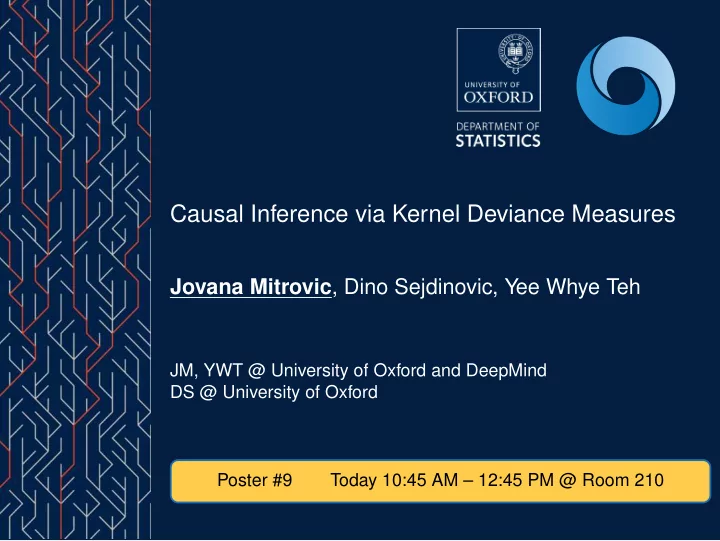

Causal Inference via Kernel Deviance Measures Jovana Mitrovic , Dino Sejdinovic, Yee Whye Teh JM, YWT @ University of Oxford and DeepMind DS @ University of Oxford Poster #9 Today 10:45 AM – 12:45 PM @ Room 210
Motivation Many scientific questions are fundamentally causal in nature, e.g. genetic drivers of diseases motives behind customer’s purchasing behaviour For answering these questions, we need experimental data! Unfortunately, often only observational data is available due to ethical, financial and technical reasons. How do we infer causal relationships from observational data? Mitrovic, Sejdinovic, Teh KCDC 2 / 5
Causal Discovery from Observational Data Prior work: Test for conditional independence → No definitive answer and not robust Assume particular functional relationship between variables and use asymmetry between cause and effect → Restrictive due to fixed functional dependence Mitrovic, Sejdinovic, Teh KCDC 3 / 5
Causal Discovery from Observational Data Prior work: Test for conditional independence → No definitive answer and not robust Assume particular functional relationship between variables and use asymmetry between cause and effect → Restrictive due to fixed functional dependence Our contribution: Kernel Conditional Deviance for Causal Inference (KCDC) general-purpose, fully non-parametric provides definitive answer does not impose a priori any assumptions on the functional relationship between variables Mitrovic, Sejdinovic, Teh KCDC 3 / 5
KCDC TL;DR Novel interpretation of asymmetry between cause and effect Minimal description length independence If X → Y , the minimal description length of the mechanism mapping X to Y is independent of the value of X , but the minimal description length of the mechanism mapping Y to X is dependent on the value of Y . Mitrovic, Sejdinovic, Teh KCDC 4 / 5
KCDC TL;DR Novel interpretation of asymmetry between cause and effect Minimal description length independence If X → Y , the minimal description length of the mechanism mapping X to Y is independent of the value of X , but the minimal description length of the mechanism mapping Y to X is dependent on the value of Y . Flexible and robust asymmetry measure using kernel embeddings of conditional distributions ◮ KCDC measure – measuring structural variability in the RKHS � 2 n � n S X → Y = 1 H Y − 1 � � � � � � � � � µ Y | X = x i � µ Y | X = x j � n n � H Y i = 1 j = 1 Mitrovic, Sejdinovic, Teh KCDC 4 / 5
KCDC TL;DR Causal discovery framework with three causal decision rules and confidence measure ◮ Direct comparison of KCDC measures ◮ Majority voting from an ensemble of direct comparisons ◮ Using KCDC measures as features within a classifier | S X → Y − S Y → X | T KCDC = Confidence measure: min( S X → Y , S Y → X ) Mitrovic, Sejdinovic, Teh KCDC 5 / 5
KCDC TL;DR Causal discovery framework with three causal decision rules and confidence measure ◮ Direct comparison of KCDC measures ◮ Majority voting from an ensemble of direct comparisons ◮ Using KCDC measures as features within a classifier | S X → Y − S Y → X | T KCDC = Confidence measure: min( S X → Y , S Y → X ) Extensive experimental evaluation against competing methods on simulated data and state-of-the-art on benchmark dataset T¨ ubingen Cause-Effect Pairs Poster #9 Today 10:45 AM – 12:45 PM @ Room 210 Mitrovic, Sejdinovic, Teh KCDC 5 / 5
Recommend
More recommend